
By Sebastián J. Bianchi
The 1939 Spange was awarded to those who received either of the first two classes of the Iron Cross in World War I, and would have earned the same class in the Second World War.
1939 Spange to the Iron Cross 2nd Class 1914

Sebastián Bianchi Collection
The Spange to the Iron Cross Second Class consisted of an eagle clutching an oak leaf wreath that encircled a mobile swastika, which was above a trapezoid featuring the year of institution (1939). The award was manufactured of Tomback or Zinc, and had a polished finish applied to it. It measured 30mm in height and 30mm in width.
The back of it was flat and most commonly had four prongs which were used to hold the device to a length of ribbon. The clasp was worn through the ribbon of the 1914 Iron Cross (which was looped on the second buttonhole), on the ribbon as party of a mounted bar of full medals, in a ribbon bar as a device attached to the 1914 slot.

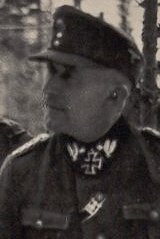
Sebastián Bianchi Collection
Manufacturers
The clasps were most commonly unmarked, if any manufacturer mark is to be found on the reverse it would that of an LDO code.
FIRM # |
FIRM |
LOCATION |
| 21 | Gebr. Godet & Co. | Berlin |
| 44 | Jakob Bengel | Idar/Oberdonau |
| 111 | Ziemer & Sohne | Oberstein |
FIRM # |
FIRM |
LOCATION |
| L/11 | Wilhelm Deumer | Lüdenscheid, Postfach 161 |
| L/12 | C. E. Juncker | Berlin SW 68, Alte Jakobstr. 13 |
| L/13 | Paul Meybauer | |
| L/15 | Otto Schickle | |
| L/16 | Steinhauer & Luck | Lüdenscheid |
| L/18 | B.H. Mayer's, Hofkunstprageanstalt | Pforzheim |
| L/50 | Gebruger Godet | Berlin |
| L/57 | Boerger & Co., | Berlin SO 16 Adalbertstr. 42 |
Click on Images to Enlarge
A cased Deumer Clasp (L/11). For more cased examples
see the Cases Section.
George Stimson Collection |
||
Two Deumer Clasps. For more pictures of the
cases see the Cases Section.
|
||
L/15 Marked Spange
George Stimson Collection |
||
L/13 Marked Spange
George Stimson Collection |
||
Two Spanges mounted on Iron Crosses. The one your
left is unmarked, the one on the right marked L/13.
George Stimson Collection |
Variations
Curved Trapezoid
One variation of the 2nd Class Clasp is the "curved trapezoid", where the outer edges of the date area are bowed. This is said to be a "first pattern" or early example.
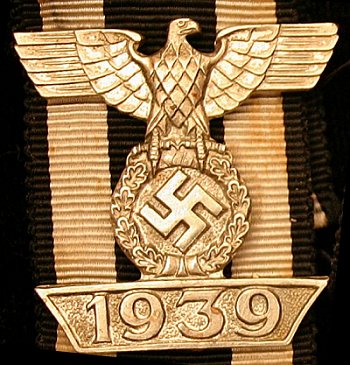
Sebastián Bianchi Collection
"Prinzen"
A smaller version of the clasp measuring 25mm by 25mm was also manufactured. This style, called "Prinzen size" by collectors, features two pins on the reverse to attach the clasp to the ribbon.
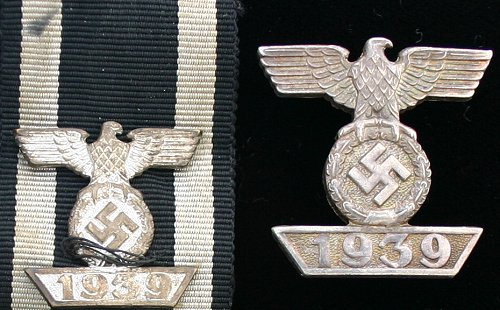
A "Prinzen Size" clasp next to a regular sized clasp.
Sebastián Bianchi Collection

Prinzen size clasp in greater detail
George Stimson Collection
Ribbon Bars
The clasp was also worn on the ribbon of the 1914 ribbon bar. Here is one such example, for more please visit the Spange Ribbon Bar Gallery (in the background is a stick pin version)

Sebastián Bianchi Collection
1939 Spange to the Iron Cross 1st Class 1914
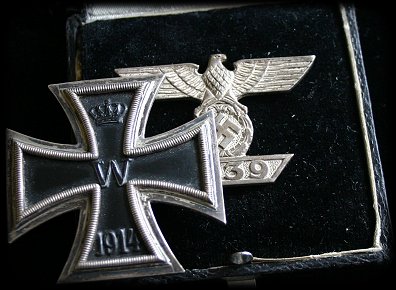
The Spange to the Iron Cross 1st Class had the same features obverse as the second class, only larger, as the width changed to 45mm (the height stayed at 30mm). The clasp was worn directly on the uniform above the Iron Cross 1st Class, and on the reverse a pin and catch system was responsible for holding the Spange to the uniform.
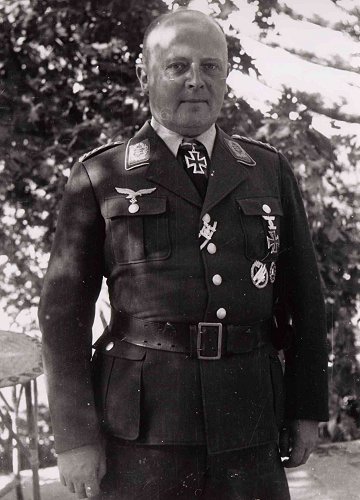
Maj. Richard Heidrich. who took over command of the FIK in late 1937 from Capt. Zahn. He left prior to operation "Yellow" per a dispute with high command on how parachute forces would be used, but came back to take command of FJR3 in August of 1940, and was awarded the RK for Kreta ( operation "merkur", in May of 1941 ). A World War I Veteran and 1914 Iron Cross recipient, he displays correct wear of both classes of Clasps.
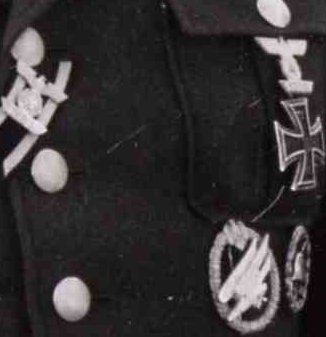
Manufacturers
The following manufactures are documented as makers of the 1st Class Spange;
FIRM # |
FIRM |
LOCATION |
| 4 | Steinhauer & Lück | Lüdenscheid |
| L/11 | Wilhelm Deumer | Lüdenscheid, Postfach 161 |
| L/12 | C. E. Juncker | Berlin SW 68, Alte Jakobstr. 13 |
| L/13 | Paul Meybauer | |
| L/15 | Otto Schickle | |
| L/18 | D.H. Mayer's, Hofkunstprageanstalt | Pforzheim |
| L/22 | Glaser & Son | Dresden |
| L/50 | Godet | Berlin |
| L/55 | Rudolf Wachtler |
 |
 |
L/13 marked Spange.
George Stimson Collection |
Unmarked Spange with Deumer characteristics.
Sebastián Bianchi Collection |
Variations
Curved Trapezoid
As with the 2nd Class, there are "scalloped" 1st Class Spange, which does not have perfectly straight sides but rather "curved" ends of the trapezoid as pictured below.
"Screw-back" Spange
Another rather uncommon variation of the Spange is the so called "screw-back" type. Instead of the pin-and-catch system, these clasps have a dome that attaches the reverse of the clasp with a (true to it's nickname) screwing mechanism. Several variations of this theme exists, two examples are pictured below.
| Two different kinds of screwback systems. The one on the top is rare curved trapezoid screwback variation. | ||
One Pieces Iron Cross-Spange
In addition to all of the above, a rather scarce variation exists where the spange is actually attached to the Iron Cross 1914 making one piece out of the two. The back of the Cross/Spange could have one pin with the hinge at the normal place for the cross with a hook on the spange, or the pin could start at the spange and be longer to reach the end of the cross.
Because this set up will reach into the four digits it has attracted the attention of fakers, so tread with care here.
![]()
© Copyright Wehrmacht-Awards.com LLC |
















